by Brian Martin
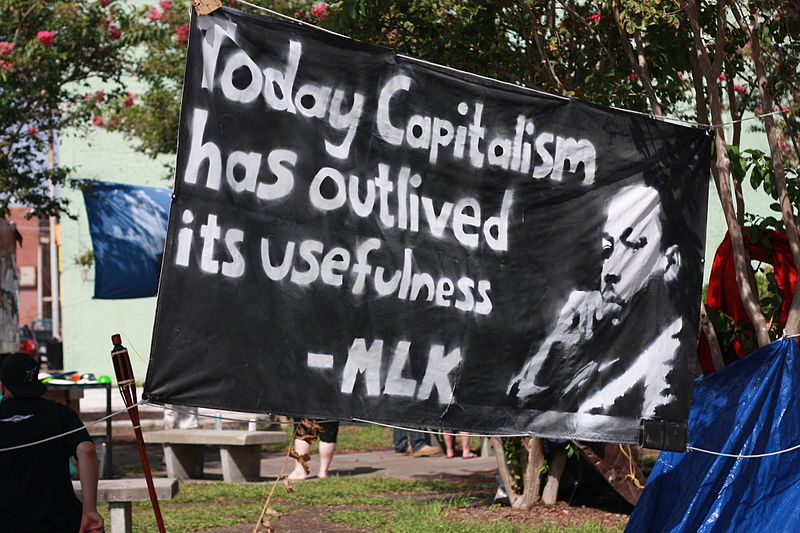
Martin Luther King banner at 2012 U.S. Republican Convention, courtesy commons.wikimedia.org
Nonviolent action provides the best hope for moving beyond capitalism to a more humane social and economic system. In the past, methods of nonviolent action such as strikes, boycotts, non-cooperation, sit-ins and alternative institutions have most commonly been used to challenge systems of direct violence, such as repressive governments. Capitalism is a more difficult system to challenge using nonviolent action because of the way it infiltrates people’s everyday thinking and behaviour. In order to develop a nonviolence strategy against capitalism, a careful analysis is required to pinpoint key areas for attention, spell out alternatives and highlight opportunities. At the core of capitalism is private ownership of the means of production, including land, factories and knowledge. This is backed up, ultimately, by the coercive power of the state. Problems with capitalism are well known, so only a summary is given here. Generally speaking, the system of ownership encourages individuals and groups to put special interests above general interests.
Read the rest of this article »
by John Moolakkattu

Gandhi quote courtesy harshitkumargupta.wordpress.com
Scott Appleby, who has done extensive research on religion and politics, concludes that a new form of conflict transformation, namely religious peace building, is taking shape in and across local communities plagued by violence. (1) Since the end of the Cold War, there has been growing cooperation between nations and peoples in the Western hemisphere, and increasing number of apologies and acts of forgiveness throughout the world. This has prompted scholars of conflict resolution to shift their focus from conflict resolution to concepts such as reconciliation and forgiveness, concepts that reflect more correctly the spirit and practice of the new age. The power of forgiveness as a means of conflict resolution or transformation was emphasised by thinkers like Hannah Arendt, as it allows human beings to come to terms with their undesirable past, thereby changing the rule that governs the power relationship between the former victimiser and his or her victim. The application of ideas and beliefs that are relevant in the personal and religious realm to politics is however a project that many political realists would find difficult to accept.Forgiveness seems to represent the personal, the private and the spiritual. The sociologist and historian John Torpey writes that the influence of Holocaust consciousness is a factor contributing to the forgiveness discourse. (2) One can also see the direct influence of restorative justice practices such as criminal justice innovations and victim-offender mediation, often drawing on aboriginal justice. However, it is the encouraging results from the experience of the South African Truth and Reconciliation Commission and the revival of the Christian idea of forgiveness that also finds reflection in most religions in one form or the other, which made the concept popular in recent years. Some even see this as a sort of opportunity for national self-reflexivity and social healing. In other words, forgiveness, once dismissed as irrelevant in the field of conflict resolution during its technical phase of rational problem solving, has now become a theme of considerable import.
Read the rest of this article »
by Brian Martin

“Knotted Book Gun”; courtesy nonviolence.com
Nonviolent action, despite its widespread use and successes, has received relatively little scholarly attention and financial support compared to military research and studies of conventional politics. Understanding the direction and content of knowledge about nonviolence is a project in the tradition of the sociology of knowledge that can help explain why the study of nonviolence has been marginalised, why misconceptions about it persist, why so much research in the area has been oriented to challenging regimes, and how nonviolence researchers are connected to nonviolence practice. This investigation leads to some suggestions for social movement scholars, in particular the value of studying agency and strategy, and the possibility of gaining insight by being involved in the movements being studied.
Read the rest of this article »
by Ali
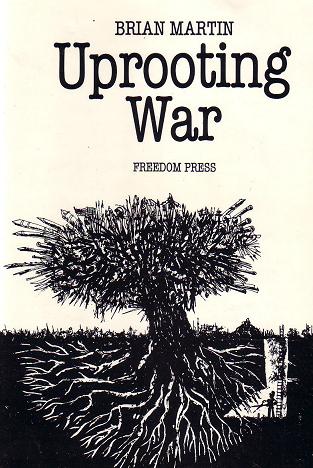
Dustwrapper art courtesy www.bmartin.cc
Editor’s Preface: This interview was conducted by email in 2006. “Ali” is an Iranian blogger and rights activist. His Persian language site can be found at lanternblog.com. As he states in the questions below, his site is censored and the last entry is dated January 2007. Please consult the notes at the end for further information. JG
Ali: Let me start with the basics and as the first question ask you as a thinker and writer on nonviolent movements to give us your definition of nonviolence?
Brian Martin: Nonviolent action includes methods such as petitions, rallies, boycotts, strikes, sit-ins, fasts and setting up alternative political structures. It’s often more informative to give examples of nonviolent action than present a formal definition. These and other such methods avoid physical violence against others, though nonviolent activists themselves may be assaulted or arrested. Nonviolent action is action that goes beyond conventional politics, so it doesn’t include lobbying or voting. Nonviolence can also be something broader, including personal behaviour that avoids oppression and efforts to promote ways of living together that are based on freedom, justice, equality and ecological sustainability.
Ali: I know that you are originally a physicist. As I’m in the field of natural science myself, the next question I ‘d like to ask is how you got into nonviolence research and studies? Can you please explain your starting ambitions for research and studies in this field?
Read the rest of this article »
by Mohandas K. Gandhi
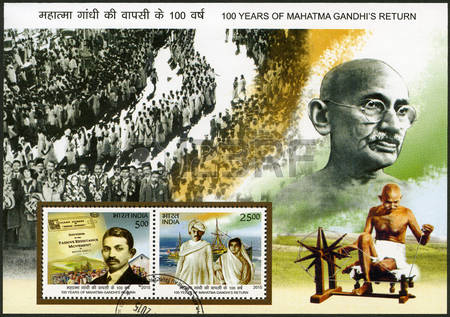
Gandhi poster commemorating his 1915 return to Indian from South Africa, courtesy www.123rf.com
Editor’s Preface: This is the last in our series of articles from the IISG/War Resisters’ International archive; it was first published in the May 3, 1946 issue of Peace News. We have selected this particular article because of Gandhi’s criticism of destruction of property, a tactic used by the Vietnam War protest movement, as with the burning of draft files. The discussion was later revisited by Occupy, and especially Occupy Oakland. Please also consult the notes at the end. JG
“I plead now for non-violence and yet more non-violence.” M. K. Gandhi
Hatred is in the air and impatient lovers of India will gladly take advantage of it, if they can, through violence, to further the cause of independence. That is wrong at any time and everywhere, but it is more wrong in a country where fighters for freedom have declared to the world that their policy is truth and non-violence.
Read the rest of this article »
by Brian Martin
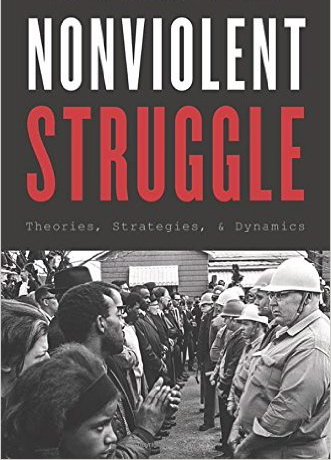
Dustwrapper for Nepstad’s book, courtesy global.oup.com
Interest in nonviolent action is greater today than it ever has been. This is reflected in the number and sophistication of nonviolent campaigns, in media coverage and popular understanding, and in new books. Several terrific new nonviolence books were published last year.
Decades ago, really good books in the area were uncommon. There was Gandhi’s autobiography, Richard Gregg’s The Power of Nonviolence (1934), and Joan Bondurant’s Conquest of Violence: The Gandhian Philosophy of Conflict (1958). These classic treatments are all in the Gandhian tradition, and each one is still worth reading today. Other favorites of mine are Bart de Ligt, The Conquest of Violence: An Essay on War and Revolution (1937), and Gene Sharp’s epic The Politics of Nonviolent Action (1973). Each of Sharp’s three parts is available separately and is a book in itself. Back in the 1970s, I read it from beginning to end, but these days many just look at Sharp’s list of 198 methods of nonviolent action. Sharp put so-called “pragmatic nonviolent action” on the agenda as an alternative or complement to the Gandhian tradition. (Please see the note at the end for bibliographical details of the above titles.)
Below I review five books published in 2015 that make important contributions to the field, and also two others published in late 2015 and in 2016. Full disclosure: I should mention that I’m not a neutral commentator. For each of the first four books, I either commented on drafts of the text or on the book proposal. As you’ll see, I think they are all excellent and worth reading. (Please see the note at the end for full details of each of the titles under review.)
Read the rest of this article »
by Terry Messman
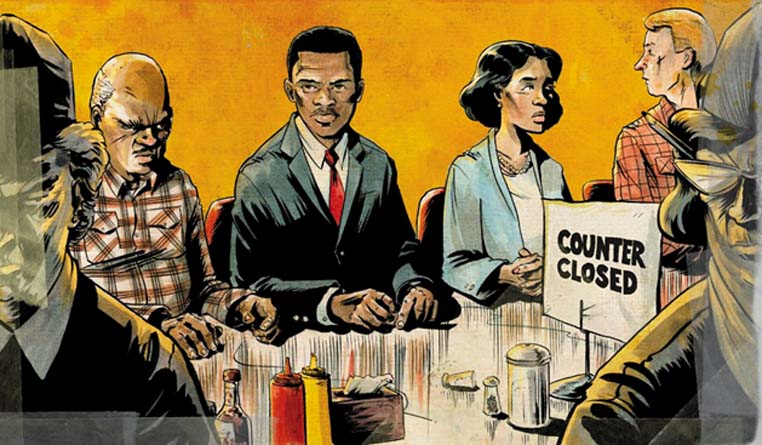
John Lewis at Nashville sit-in, book cover of March: Book One, courtesy topshelfcomix.com
Editor’s Preface: John Robert Lewis (b. 1940) is the U.S. Representative for Georgia’s 5th congressional district, and the dean of the Georgia congressional delegation. His district also includes the northern three-quarters of Atlanta. His Wikipedia page is a reliable starting point for information about his nonviolent civil rights activities and his political career. JG
It has now been 50 years since “Bloody Sunday” in Selma, Alabama, when John Lewis and Hosea Williams led some 600 civil rights marchers across the Edmund Pettus Bridge on March 7, 1965. The demonstrators attempted to march peacefully from Selma to Montgomery in support of voting rights, but state and local police viciously attacked the nonviolent procession, brutally beating them with whips and clubs, firing tear gas and charging the defenseless marchers on horseback. Hundreds of people suffered bloody beatings and some were clubbed nearly to death.
Read the rest of this article »
by Jess Clarke

Homeless in America; image courtesy web.stanford.edu
Interviewer’s Preface: Street Spirit is one of the longest-lived publications on poverty, homelessness and human rights in the United States; it is sold by homeless vendors in Oakland and Berkeley, California, and tirelessly defends the human rights of homeless people. Terry Messman produced the first issue in March 1995, and has edited and designed every issue for nearly 22 years. Please see the note at the end for further biographical details about Messman, and interviewer Jess Clarke. JC
“What matters in the long run is staying true to the cause of justice. In the end,
that is the very meaning of our lives — whether we keep going, and keep working for peace and justice,
or give up in despair. It’s the question at the very heart of it all.” Terry Messman
Jess Clarke: As the founder of Street Spirit, you’ve seen some of the important political trends in homeless organizing and human rights advocacy in the Bay Area. Looking at the big picture, when and why did you first found Street Spirit?
Terry Messman: We put out the first issue in March of 1995, so we’ve been going steadily nearly 22 years. It’s one of the longest-lived media of any kind in the nation to document the history of poverty, homelessness, and the movements to overcome economic injustice.
Read the rest of this article »
by David Barsamian
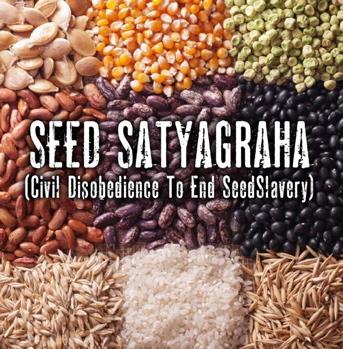
Seed Satyagraha poster courtesy navdanya.org
Interviewer’s Preface: Vandana Shiva is an internationally renowned voice for sustainable development and social justice. She spoke in New Delhi with David Barsamian, founder of Alternative Radio, during his December 2008 trip to India and Pakistan. Some say terrorism makes Gandhi irrelevant. Vandana Shiva, farmer, seed saver, and global justice activist, says we need him more than ever. Gandhi’s three pillars of freedom are now the keys to our survival. Here then are her thoughts on why Gandhi’s philosophy is still relevant—even in a world where terrorism is on the rise. Please consult the Editor’s Note at the end for biographical information about Vandana Shiva and David Barsamian. DB
David Barsamian: In the wake of the attacks on Mumbai in late November 2008, there was a piece in the (London) Sunday Express, “The Irony Gandhism Presents in Today’s Terror-Infested India.” The writer said, “It is time the government became doubly stern about its steps to combat terrorism. India may be the land of Mahatma Gandhi, but today’s situation warrants crude and cunning ways to counter extremism. That alone can ensure peace, harmony, and joy in the country.” Would you share your thoughts on this?
Vandana Shiva: Unfortunately, “crude” means of dealing with violence and terror just breed more violence and terror. As we saw after 9/11, the war on terror has created more terrorists. I think anyone who says that Gandhi is irrelevant in today’s world doesn’t understand either terrorism, its roots, or Gandhi. Suicide bombers don’t get created out of the blue; they are created as a result of decisions, systems, and processes. It’s very much like weeds in a field. One way to control weeds is by spraying Round-Up pesticides, but then you get Round-Up-resistant weeds, which are even stronger than the original weeds. That’s what is happening with terrorism.
Read the rest of this article »
by Chris Walters
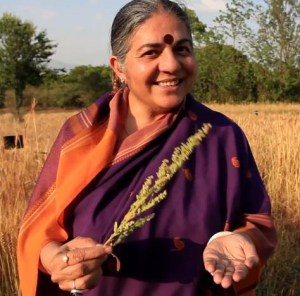
Photograph of Vandana Shiva courtesy ecofarmingdaily.com
Acres U.S.A.: How should we approach the story of Indian agriculture?
Vandana Shiva: The first thing you need to remember is that India is a land which has been farmed for 10,000 years continuously and sustains more than a billion people on its agriculture. India is the land where the British were the rulers, and in 1891 they sent John Augustus Voelcker to make a survey. He wrote a report on Indian agriculture that was published two years later. He said he could find more ways that Indian farmers could advise Great Britain about how to improve its farming than ways the British could advise India. He wrote that Indian agriculture was not backward, and that in many areas there was little or no room for improvement. Then the imperial British government sent Albert Howard to India in 1905. He arrived to find the fields were fertile. He found no pests damaging the crops, and he decided to make the study of peasant agriculture his profession. The agricultural testament that resulted from his studies became the basis of the organic movement worldwide — the Soil Association in the U.K., Rodale in the United States, all of them came out of Howard’s information, and Howard’s inspiration was ancient Indian agriculture. He so clearly distinguished between, as he said, the agriculture of the Occidental world and the agriculture of the Orient.
Read the rest of this article »














